Abstract
OBJECTIVE: To assess the contribution of coronary artery ectasia, either isolated or in association with obstructive coronary artery disease, to morbidity and mortality from ischaemic heart disease. DESIGN: A retrospective study of patients undergoing coronary arteriography at a tertiary cardiac centre. PATIENTS AND METHODS: The epidemiological, clinical, arteriographic, and follow up characteristics of three groups of patients were examined: group A, 172 patients with coronary artery ectasia and coexisting significant coronary artery disease; group B, 31 patients with coronary artery ectasia only; group C, 165 patients with significant coronary artery disease but without ectasia, matched for sex and age with group A. RESULTS: Group A patients had a similar incidence of a previous myocardial infarction to group C patients (61.6% v 64.2%), exercise performance, severity of obstructive lesions (CASS score 2.19 v 2.14), and similar distribution of diseased vessels. At follow up of approximately two years they experienced a similar incidence of unstable angina (7.5% v 4.4%) and myocardial infarction plus cardiac death (4.9% v 6.1%). They underwent bypass surgery with similar frequency (39% v 42%) but there was a lower frequency of percutaneous transluminal coronary angioplasty (5.8% v 17%, P < 0.01). Patients with pure coronary ectasia (group B) had a lower incidence of a previous myocardial infarction (38.7%, 12/31, P < 0.05) than the two other groups. The infarct in all cases was related to an ectatic artery. Their exercise performance and ejection fraction (9 (SD 3) minutes and 56.5(9)%) were higher (P < 0.01) than group A (5 (2) minutes, 48.3(10)%) and group C (5.3 (2) minutes, 49.3(10)%). Group B had no myocardial infarctions, cardiac death, surgery, or intervention at follow up; 4.4% (5/115) developed unstable angina. The incidence of angina at study entry was similar in all three groups (38.7-49.7%). CONCLUSIONS: Coronary artery ectasia does not confer added risk in patients with coexisting obstructive coronary artery disease. Although there is a measurable incidence of previous myocardial infarction, patients with pure ectasia have a good prognosis. The wisdom of giving oral anticoagulants to such patients is questioned.
Full text
PDF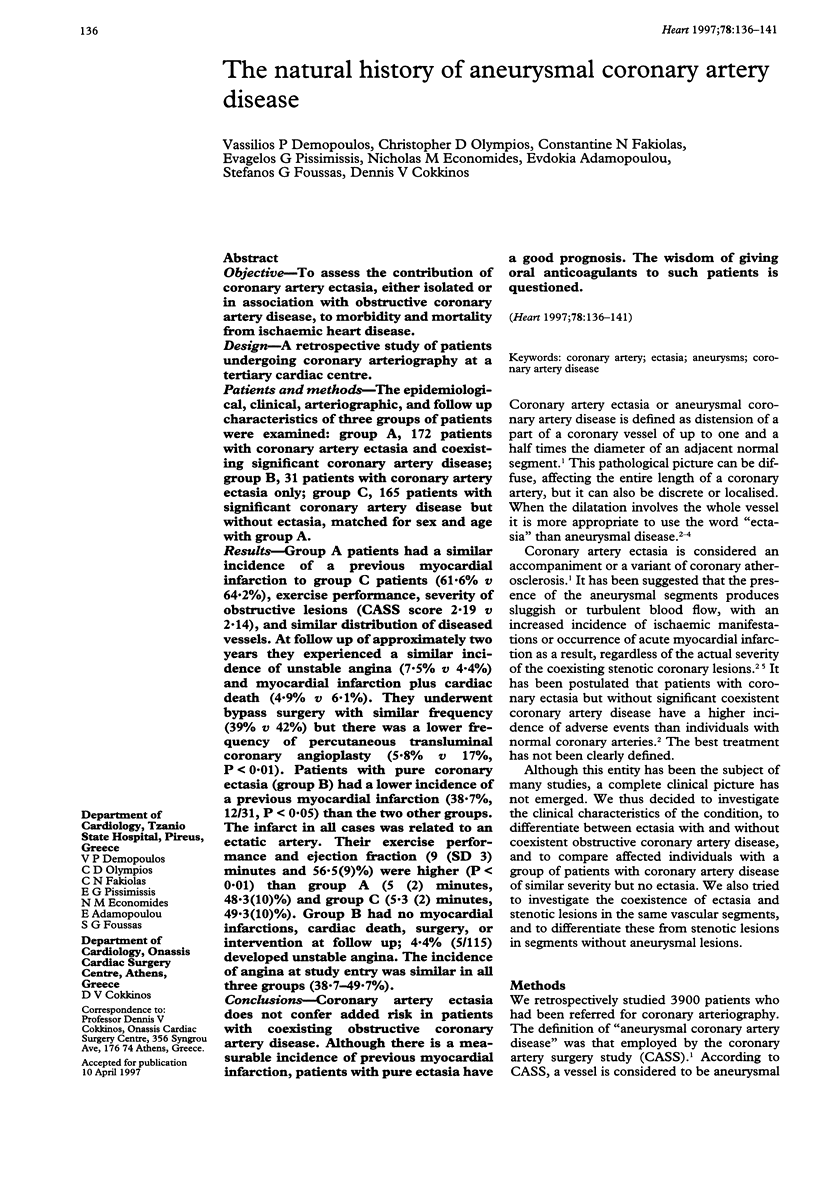
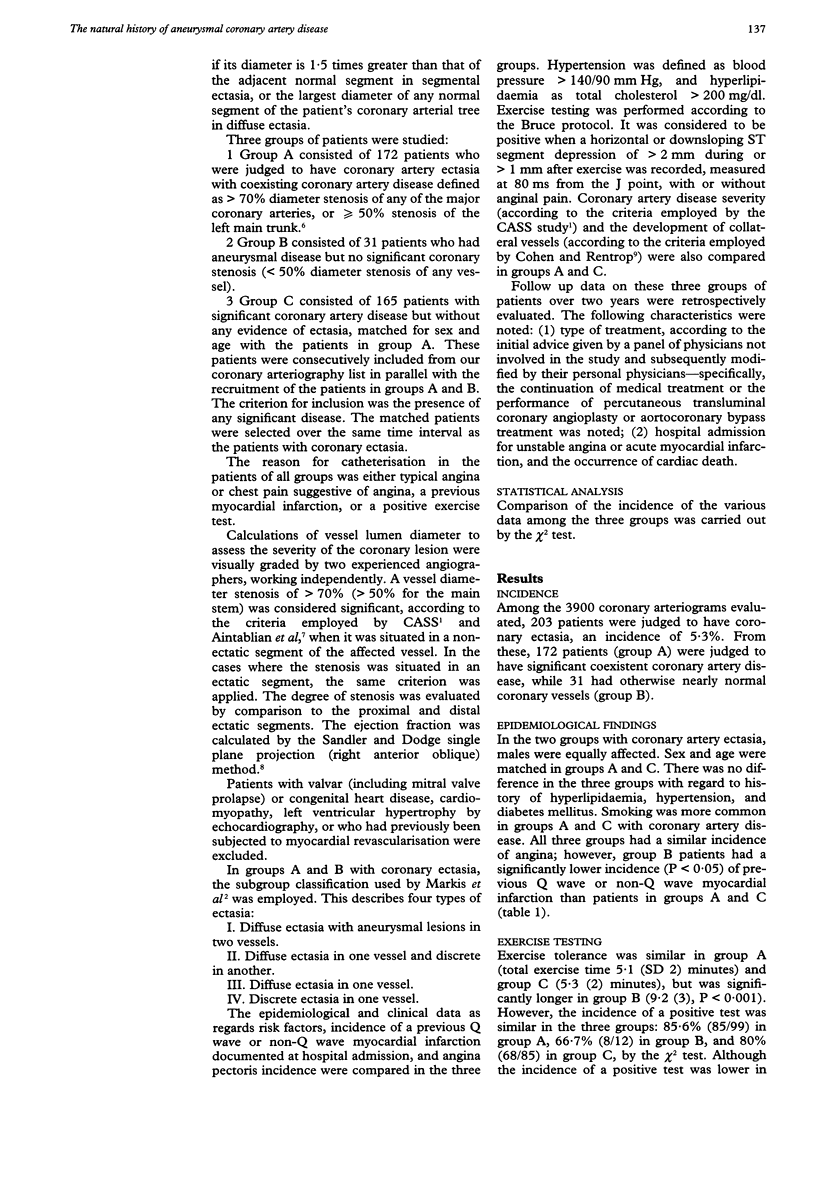
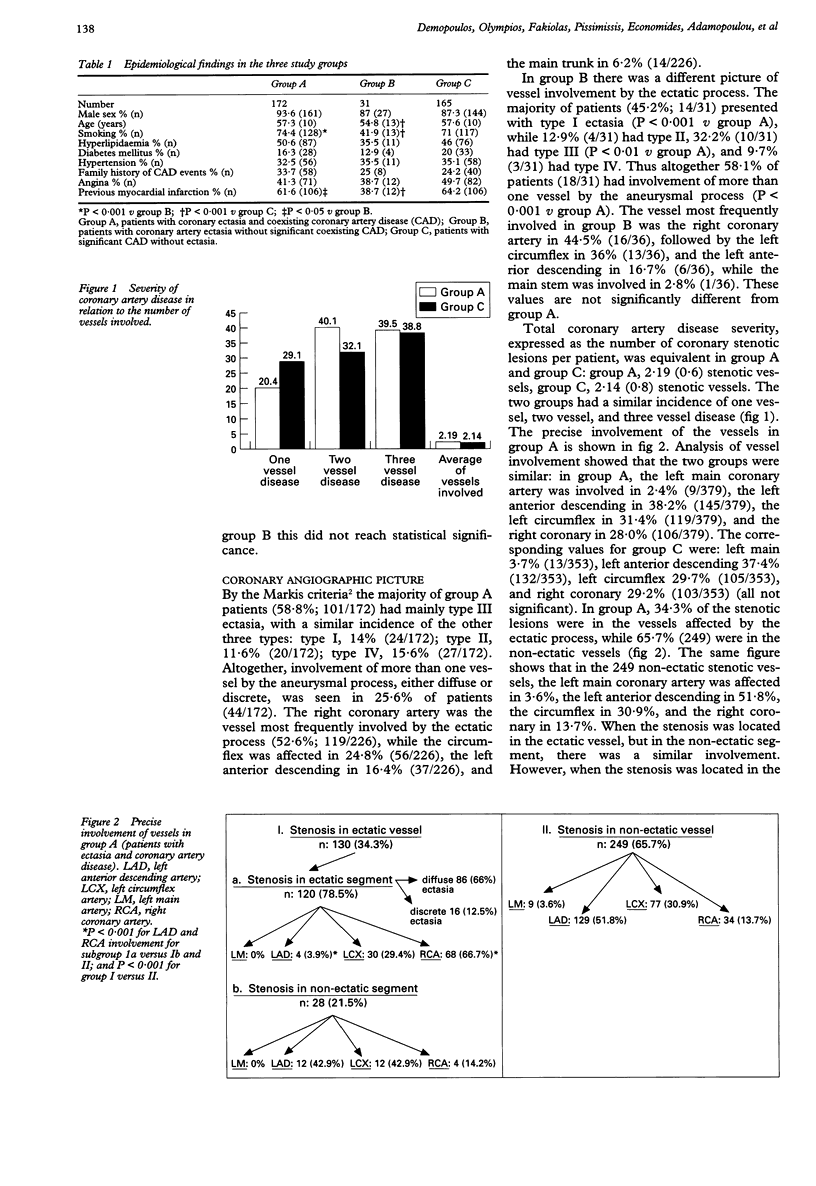
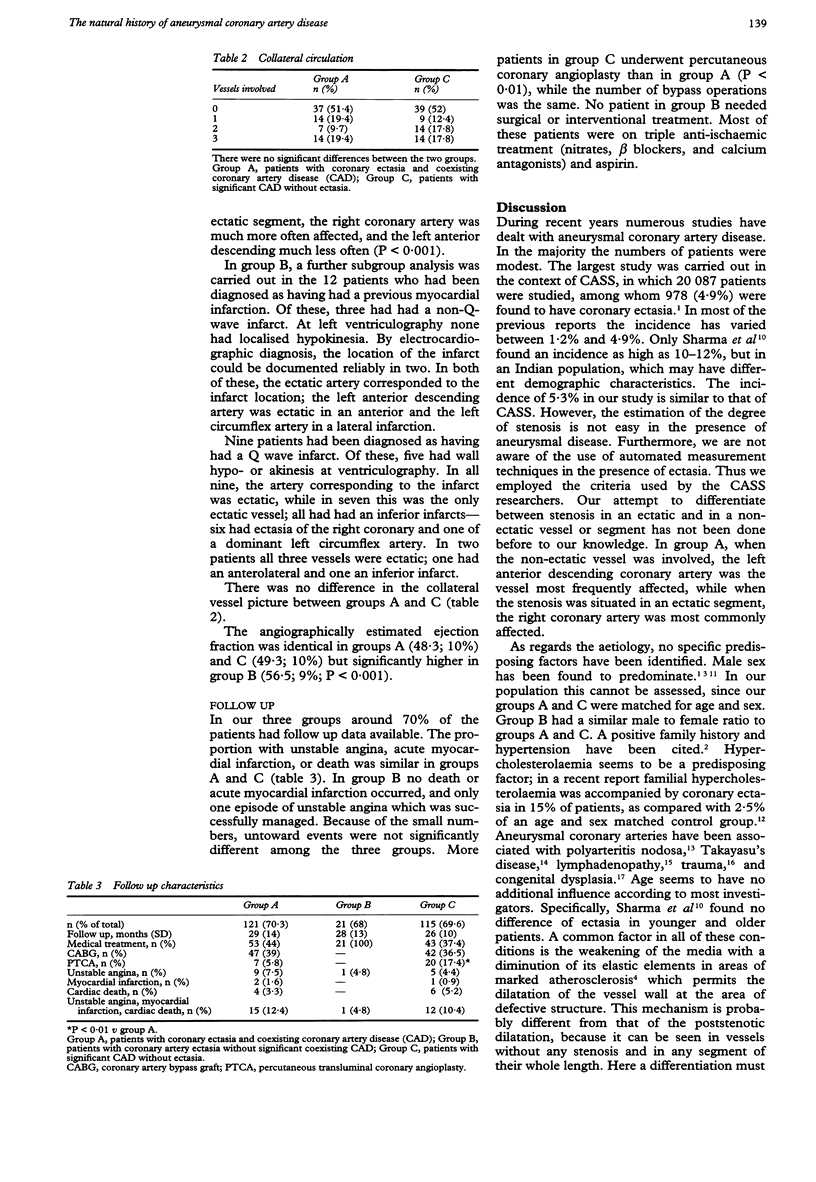
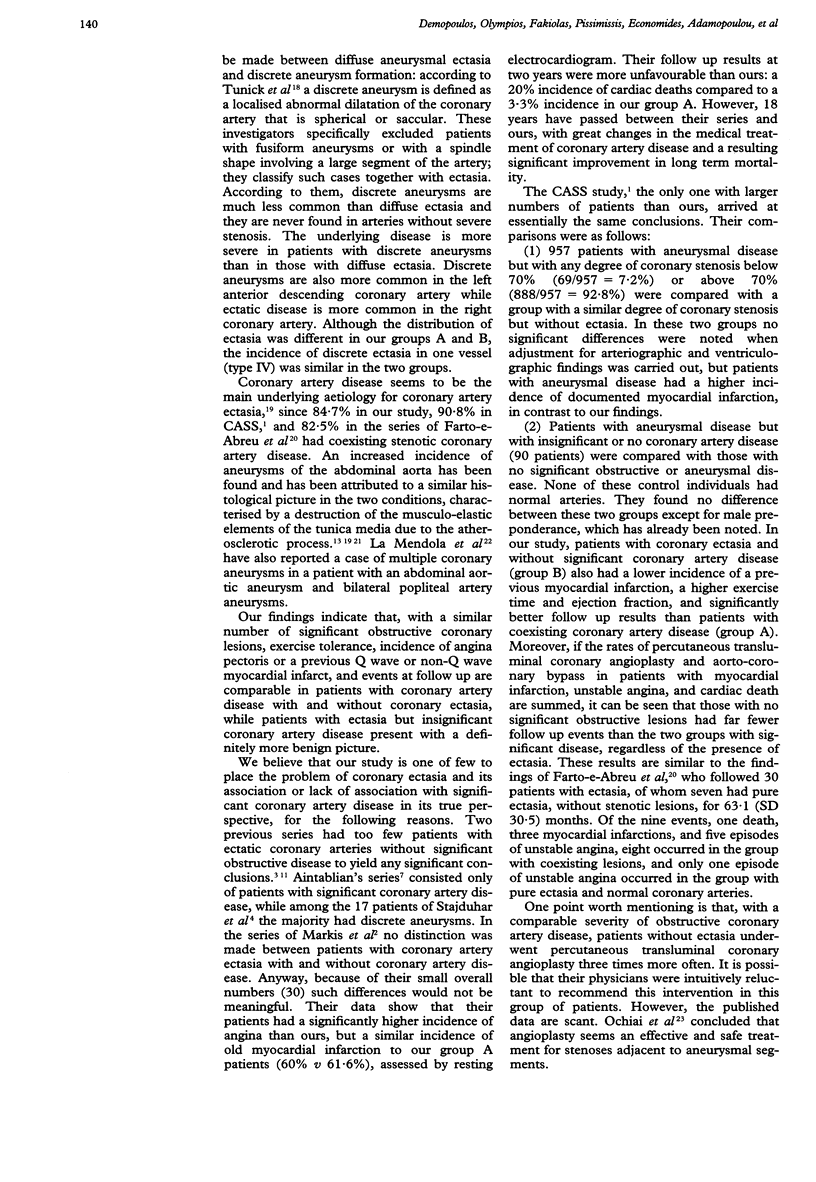
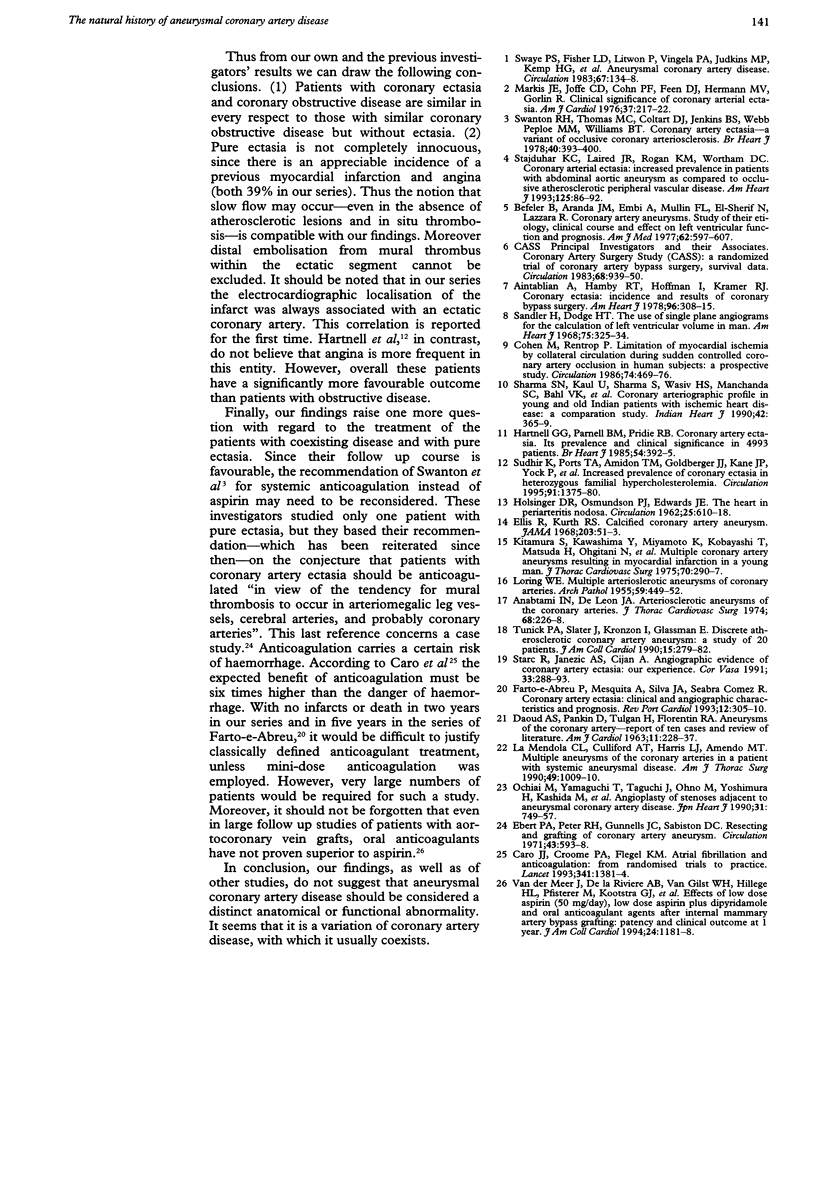
Selected References
These references are in PubMed. This may not be the complete list of references from this article.
- Anabtawi I. N., de Leon J. A. Arteriosclerotic aneurysms of the coronary arteries. J Thorac Cardiovasc Surg. 1974 Aug;68(2):226–228. [PubMed] [Google Scholar]
- Befeler B., Aranda M. J., Embi A., Mullin F. L., El-Sherif N., Lazzara R. Coronary artery aneurysms: study of the etiology, clinical course and effect on left ventricular function and prognosis. Am J Med. 1977 Apr;62(4):597–607. doi: 10.1016/0002-9343(77)90423-5. [DOI] [PubMed] [Google Scholar]
- Caro J. J., Groome P. A., Flegel K. M. Atrial fibrillation and anticoagulation: from randomised trials to practice. Lancet. 1993 May 29;341(8857):1381–1384. doi: 10.1016/0140-6736(93)90950-l. [DOI] [PubMed] [Google Scholar]
- Cohen M., Rentrop K. P. Limitation of myocardial ischemia by collateral circulation during sudden controlled coronary artery occlusion in human subjects: a prospective study. Circulation. 1986 Sep;74(3):469–476. doi: 10.1161/01.cir.74.3.469. [DOI] [PubMed] [Google Scholar]
- DAOUD A. S., PANKIN D., TULGAN H., FLORENTIN R. A. Aneurysms of the coronary artery. Report of ten cases and review of literature. Am J Cardiol. 1963 Feb;11:228–237. doi: 10.1016/0002-9149(63)90064-x. [DOI] [PubMed] [Google Scholar]
- Ebert P. A., Peter R. H., Gunnells J. C., Sabiston D. C., Jr Resecting and grafting of coronary artery aneurysm. Circulation. 1971 Apr;43(4):593–598. doi: 10.1161/01.cir.43.4.593. [DOI] [PubMed] [Google Scholar]
- Ellis R., Kurth R. J. Calcified coronary artery aneurysms. JAMA. 1968 Jan 1;203(1):51–53. [PubMed] [Google Scholar]
- HOLSINGER D. R., OSMUNDSON P. J., EDWARDS J. E. The heart in periarteritis nodosa. Circulation. 1962 Apr;25:610–618. doi: 10.1161/01.cir.25.4.610. [DOI] [PubMed] [Google Scholar]
- Hartnell G. G., Parnell B. M., Pridie R. B. Coronary artery ectasia. Its prevalence and clinical significance in 4993 patients. Br Heart J. 1985 Oct;54(4):392–395. doi: 10.1136/hrt.54.4.392. [DOI] [PMC free article] [PubMed] [Google Scholar]
- Kitamura S., Kawashima Y., Miyamoto K., Kobayashi T., Matsuda H. Multiple coronary artery aneurysms resulting in myocardial infarction in a young man: treatment by double aorta-coronary saphenous vein bypass grafting. J Thorac Cardiovasc Surg. 1975 Aug;70(2):290–297. [PubMed] [Google Scholar]
- LORING W. E. Multiple arteriosclerosis aneurysms of coronary arteries. AMA Arch Pathol. 1955 Apr;59(4):449–452. [PubMed] [Google Scholar]
- LaMendola C. L., Culliford A. T., Harris L. J., Amendo M. T. Multiple aneurysms of the coronary arteries in a patient with systemic aneurysmal disease. Ann Thorac Surg. 1990 Jun;49(6):1009–1010. doi: 10.1016/0003-4975(90)90892-a. [DOI] [PubMed] [Google Scholar]
- Markis J. E., Joffe C. D., Cohn P. F., Feen D. J., Herman M. V., Gorlin R. Clinical significance of coronary arterial ectasia. Am J Cardiol. 1976 Feb;37(2):217–222. doi: 10.1016/0002-9149(76)90315-5. [DOI] [PubMed] [Google Scholar]
- Ochiai M., Yamaguchi T., Taguchi J., Ohno M., Yoshimura H., Kashida M., Kuwako K., Isshiki T., Kurokawa K. Angioplasty of stenoses adjacent to aneurysmal coronary artery disease. Jpn Heart J. 1990 Nov;31(6):749–757. doi: 10.1536/ihj.31.749. [DOI] [PubMed] [Google Scholar]
- Sandler H., Dodge H. T. The use of single plane angiocardiograms for the calculation of left ventricular volume in man. Am Heart J. 1968 Mar;75(3):325–334. doi: 10.1016/0002-8703(68)90089-6. [DOI] [PubMed] [Google Scholar]
- Sharma S. N., Kaul U., Sharma S., Wasir H. S., Manchanda S. C., Bahl V. K., Talwar K. K., Rajani M., Bhatia M. L. Coronary arteriographic profile in young and old Indian patients with ischaemic heart disease: a comparative study. Indian Heart J. 1990 Sep-Oct;42(5):365–369. [PubMed] [Google Scholar]
- Stajduhar K. C., Laird J. R., Rogan K. M., Wortham D. C. Coronary arterial ectasia: increased prevalence in patients with abdominal aortic aneurysm as compared to occlusive atherosclerotic peripheral vascular disease. Am Heart J. 1993 Jan;125(1):86–92. doi: 10.1016/0002-8703(93)90060-m. [DOI] [PubMed] [Google Scholar]
- Starc R., Janezic A., Cijan A. Angiographic evidence of coronary artery ectasia: our experience. Cor Vasa. 1991;33(4):288–293. [PubMed] [Google Scholar]
- Sudhir K., Ports T. A., Amidon T. M., Goldberger J. J., Bhushan V., Kane J. P., Yock P., Malloy M. J. Increased prevalence of coronary ectasia in heterozygous familial hypercholesterolemia. Circulation. 1995 Mar 1;91(5):1375–1380. doi: 10.1161/01.cir.91.5.1375. [DOI] [PubMed] [Google Scholar]
- Swanton R. H., Thomas M. L., Coltart D. J., Jenkins B. S., Webb-Peploe M. M., Williams B. T. Coronary artery ectasia--a variant of occlusive coronary arteriosclerosis. Br Heart J. 1978 Apr;40(4):393–400. doi: 10.1136/hrt.40.4.393. [DOI] [PMC free article] [PubMed] [Google Scholar]
- Swaye P. S., Fisher L. D., Litwin P., Vignola P. A., Judkins M. P., Kemp H. G., Mudd J. G., Gosselin A. J. Aneurysmal coronary artery disease. Circulation. 1983 Jan;67(1):134–138. doi: 10.1161/01.cir.67.1.134. [DOI] [PubMed] [Google Scholar]
- Tunick P. A., Slater J., Kronzon I., Glassman E. Discrete atherosclerotic coronary artery aneurysms: a study of 20 patients. J Am Coll Cardiol. 1990 Feb;15(2):279–282. doi: 10.1016/s0735-1097(10)80049-x. [DOI] [PubMed] [Google Scholar]
- van der Meer J., Brutel de la Rivière A., van Gilst W. H., Hillege H. L., Pfisterer M., Kootstra G. J., Dunselman P. H., Mulder B. J., Lie K. I. Effects of low dose aspirin (50 mg/day), low dose aspirin plus dipyridamole, and oral anticoagulant agents after internal mammary artery bypass grafting: patency and clinical outcome at 1 year. CABADAS Research Group of the Interuniversity Cardiology Institute of The Netherlands. Prevention of Coronary Artery Bypass Graft Occlusion by Aspirin, Dipyridamole and Acenocoumarol/Phenprocoumon Study. J Am Coll Cardiol. 1994 Nov 1;24(5):1181–1188. doi: 10.1016/0735-1097(94)90096-5. [DOI] [PubMed] [Google Scholar]


